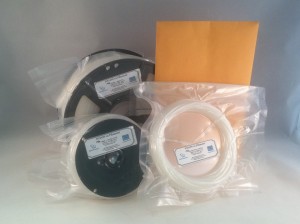General info and settings running Nylon 12 Filament
As with All Filament it should be keep in a clean dry area for best results!
One of the foremost complaints when using other printing filaments is the absorption of moisture. Whether in the original raw material before extrusion or after sitting in a finished product “Filament Material” moisture can cause end use problems while using it for printing. Because of the long “hydrocarbon chain length” found in processed Nylon 12, it absorbs very little moisture. Table 1 provides comparisons of Nylon 12 to other materials.
| Common Plastic Shrinkage Rates | |
|---|---|
| Description | Shrinkage in/in |
| ABS High Impact | 0.005 - 0.007 |
| ABS Heat Resistant | 0.004 - 0.005 |
| ABS Medium Impact | 0.005 |
| Nylon 6/6 | 0.010 - 0.025 |
| Nylon 6/6 | 0.007 - 0.015 |
| Nylon 6/10 | 0.010 - 0.025 |
| Nylon 11 | 0.010 - 0.025 |
| Nylon 12 | 0.008 - 0.020 |
| Nylon Glass Filled | 0.005 - 0.010 |
| PET | 0.003 - 0.005 |
| Polyethylene Low Density (LDPE) | 0.015 - 0.035 |
| Polyethylene High Density (HDPE) | 0.015 - 0.030 |
| PPO/Styrene CO (NORYL) | 0.005 - 0.007 |
| Polypropylene | 0.010 - 0.030 |
| PPO/Styrene G.P. | 0.002 - 0.008 |
| PPO/Styrene Heat Resistant | 0.002 - 0.008 |
| PPO/Styrene Impact Mod | 0.003 - 0.006 |
The lower the absorption rate the better for you when printing and storing your Nylon 12 Filament.
There are 2 things that can be affected due to moisture in the filament:
1. Water causes pockets to form in the filament. These pockets can swell under heated conditions. This in turn prevents the filament from a smooth transition through the hot end, causing jams and potentially requiring replacement. Minimum “bubbles or pockets” of moisture and air in the filament do not and should not cause problems. Since the filament re-melts in the extruder head and is used at a good rate, these small imperfections should have little to no effect on the final product.
2. Large(r) pockets of moisture can alter the flow of material from the printer extruder head. This will in turn create less than desirable results in your finished part as well as spitting and “spider hairs” over the part and print head.
Bottom line is the less moisture the material can absorb the better running conditions and end product for you. This provides a high degree of dimensional stability even in higher humidity conditions.
Other important facts you should learn more about;
- Even if temperatures dip below freezing Nylon 12 will retain excellent non-impact and impact strength.
- It has superior chemical resistance.
- High resistance to stress cracking
- Strong abrasion resistance characteristics
- Highly fatigue resistant
- Better part surface finish and feature details
Running Conditions:
This material is constantly being tested for the best running conditions. It has been tested over the last year on many different printers. To be successful you must run on a 3d printer that has a heated bed. The second most important thing is to use an “adhesive” like our Fubar Glue. This is necessary to stop not only our Nylon 12 Filament from lifting and warping but just about any plastic filament used in 3d printing today. Shrinkage due to filament (plastic) cooling is a fact. Our product will eliminate or severely reduce these effects. We have found the following conditions will provide the best results.
You can use:
|
DESCRIPTION: |
SETTING or USE:** |
| Material bed: | Garolite, Aluminum, Glass |
| Preset Bed Temp: | 80°C to completely dry the coating of Fubar Glue before using… |
| 1st Pass: | 235-265°C Nozzle Temp |
| After 1st Pass: | 70-75°C Bed Temp |
| Nozzle Temp: | 245°C or adjust accordingly |
| Nozzle Size: | 0.4mm |
| Retraction Speed:
Default Retraction: Our Preference: |
2mm/0.1mm Φ (i.e.: 2mmx0.4mm=8mm)
Fast (We like to cut to 50% of that) 10mm Avg. |
| Print Speed: | 25-125mm/sec or greater using a 0.4mm tip depending on complexity of product and the type of filament used. |
|
**These conditions are provided as a courtesy only. There are no guarantees expressed or implied as to the correctness or usability on any machine. As with using any materials, experience and testing will yield the greatest results for your machine and end product.
|
|
Check our FAQ and other articles to familiarize yourself with our products and answer some of your questions..

